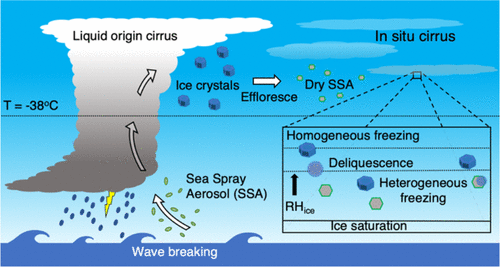当前位置:
X-MOL 学术
›
ACS Earth Space Chem.
›
论文详情
Our official English website, www.x-mol.net, welcomes your
feedback! (Note: you will need to create a separate account there.)
Is Ice Formation by Sea Spray Particles at Cirrus Temperatures Controlled by Crystalline Salts?
ACS Earth and Space Chemistry ( IF 2.9 ) Pub Date : 2021-08-17 , DOI: 10.1021/acsearthspacechem.1c00228 Ryan J. Patnaude 1 , Russell J. Perkins 1 , Sonia M. Kreidenweis 1 , Paul J. DeMott 1
ACS Earth and Space Chemistry ( IF 2.9 ) Pub Date : 2021-08-17 , DOI: 10.1021/acsearthspacechem.1c00228 Ryan J. Patnaude 1 , Russell J. Perkins 1 , Sonia M. Kreidenweis 1 , Paul J. DeMott 1
Affiliation

|
The ice nucleating ability of sea spray aerosol (SSA) particles has been explored in recent years due to the abundance of SSAs in the atmosphere. The role of SSAs in ice nucleation extends to cirrus clouds, due to processes that loft SSAs to the upper troposphere. This is of special relevance because of the frequent occurrence of cirrus in the atmosphere, their role in the Earth’s radiative balance, and uncertainties regarding how aerosols may affect their formation and evolution. In this study, a continuous flow diffusion chamber (CFDC) is used to investigate the ice nucleating ability of size-selected particle distributions of SSAs and its primary constituent sodium chloride (NaCl) at temperatures <235 K. Results show that, above ∼220 K, the majority of NaCl and SSA particles fully deliquesce and freeze via homogeneous nucleation at or below water relative humidities, RHw, of ∼95%. However, below 220 K, the onset RHw of freezing for NaCl and SSA particles is much lower, at ∼75%, where strong heterogeneous freezing of 10% of the aerosol population occurs. Similar heterogeneous freezing behavior for NaCl and SSA particles, occurring near their predicted deliquescence RHw, points toward SSA freezing at the lowest temperatures being controlled by the crystalline salts. Finally, the calculations of ice nucleation active surface site densities show that particle size does not dictate the efficiency of freezing for NaCl and SSA particles. These results indicate SSAs as a potentially significant source of ice nucleating particles at cirrus temperatures, with the ability to contribute to cirrus-mediated climate impacts if sea spray emission and transport scenarios change in the future.
中文翻译:

在卷云温度下由海浪粒子形成的冰是否受结晶盐的控制?
近年来,由于大气中存在大量的 SSA,人们对海喷雾气溶胶 (SSA) 颗粒的冰成核能力进行了探索。由于将 SSA 提升到对流层上层的过程,SSA 在冰核形成中的作用延伸到卷云。由于卷云在大气中频繁出现,它们在地球辐射平衡中的作用以及气溶胶如何影响其形成和演化的不确定性,这具有特殊的相关性。在这项研究中,连续流动扩散室 (CFDC) 用于研究 SSA 及其主要成分氯化钠 (NaCl) 的尺寸选择粒子分布在 <235 K 温度下的冰成核能力。结果表明,高于 ~220克,w,约为 95%。然而,在 220 K 以下,NaCl 和 SSA 颗粒冻结的起始 RH w低得多,约为 75%,其中 10% 的气溶胶群体发生强烈的异质冻结。NaCl 和 SSA 颗粒的相似异质冷冻行为,发生在它们预测的潮解 RH w附近,指向由结晶盐控制的最低温度下的 SSA 冻结。最后,冰成核活性表面位点密度的计算表明,粒径并不决定 NaCl 和 SSA 颗粒的冷冻效率。这些结果表明,SSA 是卷云温度下冰核粒子的潜在重要来源,如果未来海喷雾排放和运输情景发生变化,有能力对卷云介导的气候影响做出贡献。
更新日期:2021-09-16
中文翻译:

在卷云温度下由海浪粒子形成的冰是否受结晶盐的控制?
近年来,由于大气中存在大量的 SSA,人们对海喷雾气溶胶 (SSA) 颗粒的冰成核能力进行了探索。由于将 SSA 提升到对流层上层的过程,SSA 在冰核形成中的作用延伸到卷云。由于卷云在大气中频繁出现,它们在地球辐射平衡中的作用以及气溶胶如何影响其形成和演化的不确定性,这具有特殊的相关性。在这项研究中,连续流动扩散室 (CFDC) 用于研究 SSA 及其主要成分氯化钠 (NaCl) 的尺寸选择粒子分布在 <235 K 温度下的冰成核能力。结果表明,高于 ~220克,w,约为 95%。然而,在 220 K 以下,NaCl 和 SSA 颗粒冻结的起始 RH w低得多,约为 75%,其中 10% 的气溶胶群体发生强烈的异质冻结。NaCl 和 SSA 颗粒的相似异质冷冻行为,发生在它们预测的潮解 RH w附近,指向由结晶盐控制的最低温度下的 SSA 冻结。最后,冰成核活性表面位点密度的计算表明,粒径并不决定 NaCl 和 SSA 颗粒的冷冻效率。这些结果表明,SSA 是卷云温度下冰核粒子的潜在重要来源,如果未来海喷雾排放和运输情景发生变化,有能力对卷云介导的气候影响做出贡献。










































 京公网安备 11010802027423号
京公网安备 11010802027423号